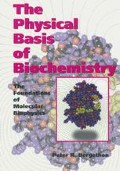Abstract
If electrostatic forces define the chemical shape of our world, to a great degree it is the movement of charge that brings that world to life. The movement of charge is necessary for sensation, mental activity, muscular movement, and energy transduction by photosynthesis and metabolism, to name just several examples. When an electric field exists in either free space or a conducting medium, charges will move under the field’s influence. This movement of charge is the electric current. The flow of charge in a vacuum is familiar to most readers as the electron beam of a television or oscilloscope. Movement of charge is more familiar today in the solid state, whether in metal or polymer conductors or in semiconductors. It is probable that within this generation the cathode ray tube will be of only historical interest, having most likely been replaced by solid state display devices. Movement of charge in the solid state is generally impeded by the presence of the atomic and molecular structure that composes the material through which charge flows. We will review the physical principles of conduction through conductors and semiconductors and then delve much more deeply into the molecular particulars of conduction in substrates of biological interest in later chapters.
Access this chapter
Tax calculation will be finalised at checkout
Purchases are for personal use only
Preview
Unable to display preview. Download preview PDF.
Further Reading
General
Feynman R. R, Leighton R. B., and Sands M. (1963) The Feynman Lectures on Physics, volume 1. Addison-Wesley Publishing Co., Reading, MA.
Fishbane R M., Gasiorowicz S., and Thornton S. T. (1993) Physics for Scientists and Engineers. Prentice Hall, Englewood Cliffs, NJ.
Halliday D., Resnick R., and Walker J. (1995) Fundamentals of Physics, 5th ed. John Wiley and Sons, New York.
Tipler R A. (1982) Physics. 2d ed. Worth Publishers, New York.
Warren W. S. (1993) The Physical Basis of Chemistry. Academic Press Co., San Diego.
History
Williams L. P. (1989) André-Marie Ampère. Sci. Am., 260 (1): 90–97.
Electric and Magnetic Effects in Biological Systems
Hille B. (1992) Ionic Channels of Excitable Membranes, 2d ed. Sinauer Associates, Sunderland, MA. The first several chapters are an excellent summary of the application of electrical circuit models to excitable biological membranes.
Hsu C. Y., and Li C. W. (1994) Magnetoreception in honeybees. Science, 265: 95–97.
Polk C., and Postow E., eds. (1986) Handbook of Biological Effects of Electromagnetic Fields. CRC Press, Boca Raton, FL. This is a collection of articles exploring interactions of electric and magnetic vectors with elements of biological systems.
Tenforde T. S. (1991) Biological interactions of extremely-low-frequency electric and magnetic fields. Bioelectrochemistry and Bioenergetics, 25: 1–17.
Mass Spectrometry
Arnott D., Shabanowitz J., and Hunt D. F. (1993) Mass spectrometry of proteins and peptides: Sensitive and accurate mass measurement and sequence analysis. Clin. Chem., 39: 2005–2010.
Jardine I. (1990) Molecular weight analysis of proteins. Methods in Enzymology, 193: 441–55.
Chait B. T. and Kent S. B. H. (1992) Weighing naked proteins: Practical high accuracy mass measurement of peptides and proteins. Science, 247: 1885–94.
Hofstadler S. A., Bakhtiar R., and Smith R. D. (1996) Electrospray ionization mass spectrometry: Part I, Instrumentation and spectral interpretation. J. Chem. Ed., 73: A82 - A88.
Author information
Authors and Affiliations
Rights and permissions
Copyright information
© 1998 Springer Science+Business Media New York
About this chapter
Cite this chapter
Bergethon, P.R. (1998). Physical Principles: Electromagnetics. In: The Physical Basis of Biochemistry. Springer, New York, NY. https://doi.org/10.1007/978-1-4757-2963-4_8
Download citation
DOI: https://doi.org/10.1007/978-1-4757-2963-4_8
Publisher Name: Springer, New York, NY
Print ISBN: 978-1-4757-2965-8
Online ISBN: 978-1-4757-2963-4
eBook Packages: Springer Book Archive

